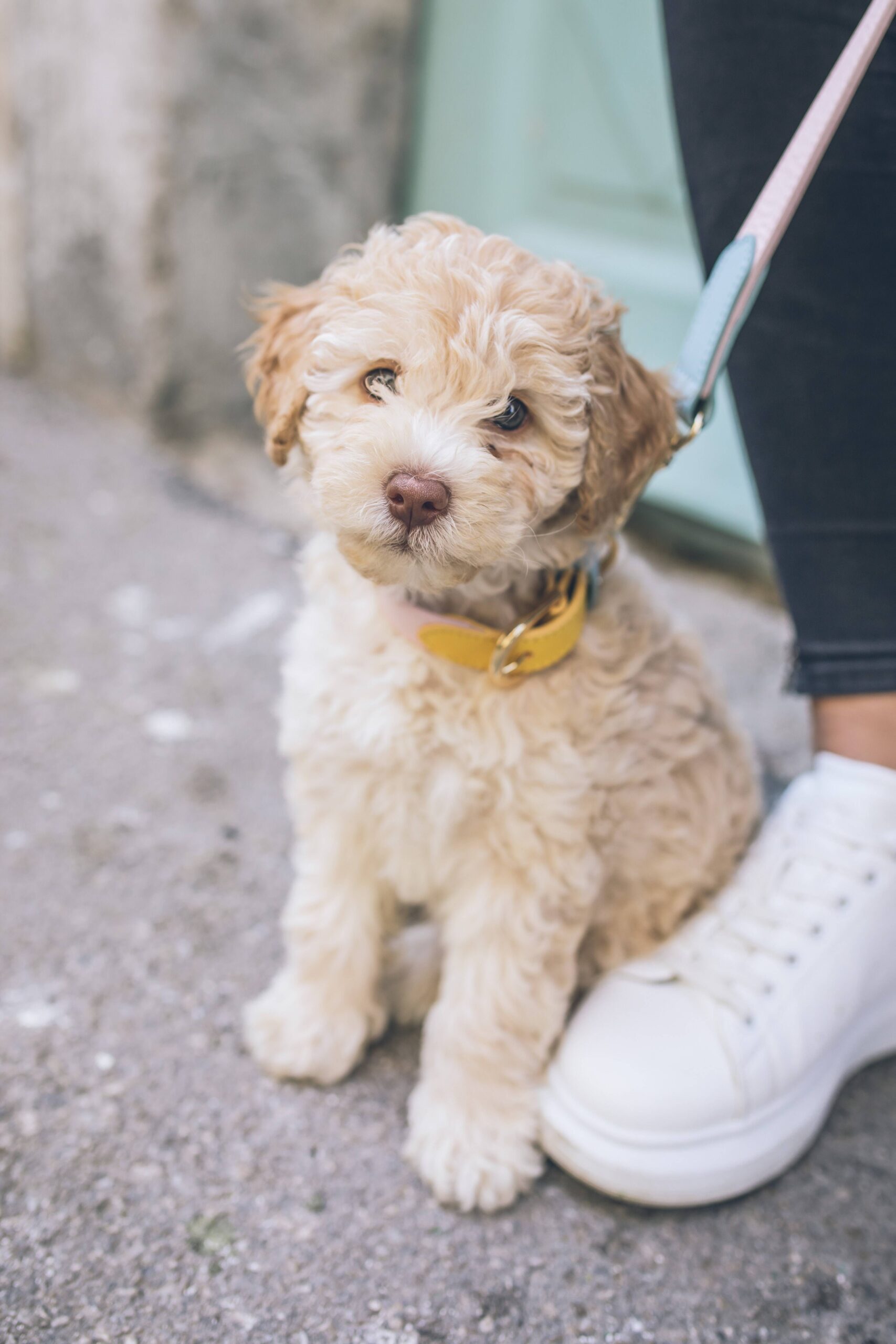
The Eglu Classic Chicken Coop is an easy to move starter chicken house suitable for 2-4 birds.
Unless you know exactly when your hens were born, it is difficult to determine their exact age. We can’t simply ask them how old they are, so we have to make educated guesses based on their looks and behavior.
Like most animals, a chicken’s looks and behavior gradually change as they age. It is the visible evidence of these life stages that helps us determine a hen’s age. Young birds are the easiest ones to identify, as chicks do not have a complete set of adult feathers, beginning life with the short-lived fluffy yellow coating called down. They wear this attractive yellow coat for the first week or so of their lives.
After the first couple of weeks, chicks gradually molt their down and small feathers begin to grow to replace it. A baby chicken can be considered a chick until it sheds all its down, which usually takes around 12 weeks.
So, if a chicken still has some down, chances are it is 12 weeks old or less, although some breeds may take a while longer to shed all their baby fluff. But, generally, the more down, the younger the bird.
From chick to pullet
Once a chick has molted and lost its down, it enters the transitional period between chick-hood and adulthood, the chicken equivalent of teenage years. Hens over the age of 12 weeks are in this phase, and are known as pullets. This period of their lives usually lasts until 20 weeks old, though it can be longer. The name ‘pullet’, though, is generally used for any hen under one year.
Pullets are considered adults when they lay their first eggs, which occurs somewhere between 18 and 25 weeks. Male chickens – cockerels, or roosters – reach adulthood when they start to crow and show an interest in the hens, usually by chasing them. This occurs at around five months old, although some breeds are later developers.
At this point in a chicken’s life, when it has finally become an adult bird, it is hard to pinpoint exactly how old they are. If your hens are not laying eggs yet but have all their adult plumage, they are most likely somewhere between 12 and 20 weeks old. Young hens of this age will tend to have smaller combs than fully adult birds.
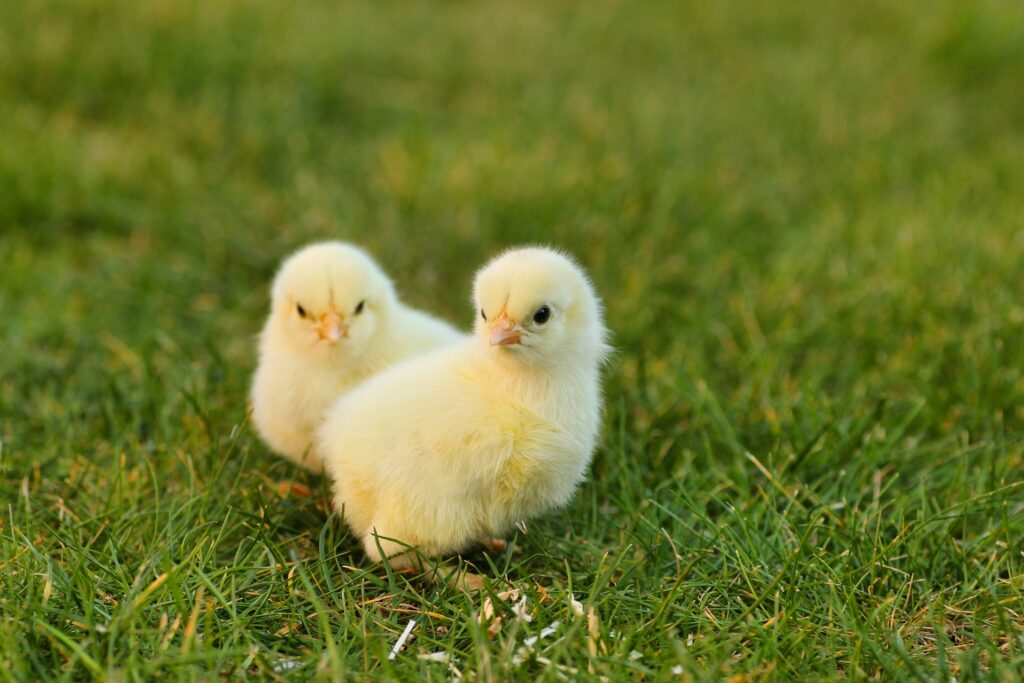
From pullet to adult hen
If you are keeping multiple hens, it can be hard to tell if an individual bird has started laying or not. Pullets will have small, dry and pale vents in comparison to hens, and this can be used as a way of telling whether or not they are laying.
During this post-20-week period, both the pullets’ and cockerels’ combs and wattles will gradually become brighter and more pronounced. Birds with less vibrant combs and wattles are most likely to be aged around 12-15 weeks. It is during this prime egg-laying stage of a chicken’s life that their combs and wattles will be at their most vibrant – as a hen ages, it slowly loses the red color.
Hens increase their body mass as they mature, and most have reached maximum plumes at nine months old.
Signs of an adult chicken
Once your pullet has laid its first egg, and your cockerel has started crowing and harassing the hens, they have reached adulthood. Despite the fact that they are considered adults at this point in their lives, they are still growing (albeit slower) and will reach their final size and weight at around one year.
At this age, hens will usually be laying one egg per day, and the cocks will spend a lot of time chasing the hens. At the age of 18 to 20 weeks, the chickens will have their first feather molt.
Guessing the age of a fully grown chicken that has had its first molt is more challenging. However, there are some features that help us determine their age with reasonable accuracy.
- A young cock will have short spurs, a little under 1cm in length. By the time your rooster is two years old, their spurs will have grown and may reach lengths of 2.5cm-3cm.
- Hens that lay an average of five to six eggs per week are probably in the first two years of their life
- For the first two years of their adult life, both hens and cocks will be in their prime. This manifests in vibrant feather colors, smoother legs than older birds and colorful combs and wattles.
Older hens and roosters
At around the second year of their lives, chickens will enter the second half of their adult lives. It is usual at this time for hens to stop laying daily, and cockerels will start showing less interest in the hens.
During this time, a chicken’s legs will start to get rougher and scalier, and their combs, wattles and feathers will become less vibrant.
However, although past their prime, at this point in their lives, a chicken will still have around between two and five years left in them, depending on the breed. As they get older, hens will only lay occasionally, and the eggs may be larger than the ones they laid as young birds. However, some breeds continue laying into their fourth year, and some can live up to 10 years or more.
This entry was posted in Chickens on August 26th, 2021 by alisa.deluca

Photo by Joe Caione on Unsplash
Getting a new puppy is such an exciting time for everyone involved (even if it means a manic few months ahead of you!). A cross between a poodle and cocker spaniel, cockapoos have soared in popularity over the past few years, with their hypoallergenic coat and undeniably cute looks both playing a huge part in this! With such a loving and fun temperament, it’s hardly surprising that they have become a new firm family favorite. So, now you’ve decided that a cockapoo is the right puppy for you, where exactly do you start? Writing a puppy checklist is a good idea to get prepared before you bring your pet pooch into their new home.
Essentials for Before They’re Home
The first few days with your new puppy might be tough, as they adapt to your life and you become familiar with your four legged friend. Every dog is different but there are some essentials that we recommend for your cockapoo before even bringing them home that will make for a much easier start.
Food and Water (Including Bowls)
Puppies, of course, need a fresh supply of food and water (along with appropriate sized bowls for each). A reliable cockapoo breeder will tell you know what food your cockapoo puppy has been on before they come home, to make for a less stressful transition. Be sure to also purchase treats for your new furry friend. They’re a fantastic way to start the training process and will keep your puppy motivated.
Collar and Leash
When you pick your puppy up, they’ll probably have had a collar on to differentiate them from their litter-mates. However, you’ll want to purchase your own, even before they are able to go for their first walk. This will help to train them to get used to the feeling of a leash and collar. For size reference, cockapoos are generally medium sized dogs but this can range depending on what type of poodle they are mixed with. The general rule of thumb is that you should be able to fit two fingers under your cockapoo’s collar. Alternatively, you may wish to opt for a harness. Whichever you decide for your new cockapoo pup, make sure they are fitted with an ID tag, which states your name, first line of your address, postal code, contact number, and a message that indicates that your dog has been microchipped i.e. “I’m microchipped”.
A Crate and Bedding
When you bring your puppy home you should introduce them to a crate. A crate should never be used as a cage or to punish your dog, but should work as a den for your new cockapoo. The Omlet Fido Studio Dog Crate allows your dog to have their own private and safe place in the house, while the modern design will complement your home. Happy owner and happy pup!
Puppies need sleep, and a lot of it! So comfortable bedding for your cockapoo puppy is essential. Your Fido Studio Crate can also be very easily fitted with a wide range of dog beds. The easy clean Bolster dog bed is perfect for puppies and it’s quick and easy to zip off the cover to throw in the washing machine when it’s time for a freshen up!
A Few Extras For Your Cockapoo
Puppy pads
Cockapoos are remarkably intelligent and many puppies take to toilet training within the first few weeks. For when your pup arrives home it really is a personal preference as to whether you’d like to use puppy pads for toilet training or not. Puppy pads are massively convenient, especially to those with limited outdoor space. However, if getting up in the middle of the night to take your puppy to the bathroom isn’t a problem for you then you may wish to avoid this product as your pup may find it difficult or confusing to transition between the pads and outdoor peeing.
Toys
Pups love to play and cockapoos are no different here. Known for their outgoing, playful personalities, you’ll need to be stocked up with plenty of puppy toys to keep their minds occupied. Toys are also great for when you have to start leaving your puppy alone. Do make sure however, that any toys you leave with them are safe, age appropriate, and cannot be consumed! Puppies also love to chew, especially as they get into the teething stage. Be sure to explore different styles of dog toys to see how you can keep your cockapoo entertained and help with their chewing.
Grooming Kit
Although it’s wise to take your cockapoo to a professional groomer now and again, it’s also important to upkeep their grooming at home too. Purchasing a brush, comb, dog shampoo, and nail clippers is a great place to start. However, as cockapoos are of course a mixed breed, their coat type may vary. When your puppy reaches around seven to nine months old, they’ll develop their ‘adult coat’ and you will have a better indication of the best way to groom your dog.
Hopefully all the time spent preparing to bring your new puppy to their new home will help your family to transition better to life with your new furry friend!
This entry was posted in Dogs on August 19th, 2021 by alisa.deluca

Why won’t hens lay in their nesting box? Chicken keepers sometimes find themselves picking eggs up off of the ground or in other inappropriate places. It’s frustrating when hens decide to ignore the carefully placed and meticulously kept nesting boxes you have provided them with, and instead choose to lay their eggs wherever they see fit. Hens thrive on routine, so once they create a habit of laying eggs wherever they’d like, it can be hard to convince them otherwise. See how you can retrain your hens to lay where they should, or to prevent them from deviating from the nesting box in the first place.
Understanding egg-laying behavior
To begin unraveling the mystery of why hens lay their eggs outside of their nesting box, it helps to understand what might be causing them to veer away from their normal routine. Healthy hens that feel their best will naturally seek out comfortable, secluded spaces to lay their eggs. And, as flock animals, they will gravitate toward a location where other hens have chosen to lay – happily contributing to the previously laid eggs.
Hens that suddenly start routinely laying their eggs outside of their nesting boxes are likely:
- Not feeling well
- Reacting to a perceived threat
- Don’t feel comfortable in their provided nesting area
- Feeling crowded in their space
Broody hens also run off other hens that may be trying to lay in the nesting box. A hen that has decided to sit in order to hatch eggs will stay in the nesting box for the required 21 days if they aren’t made to move. As most broody hens are aggressive and territorial, they will protect their nest and not allow other hens to lay their eggs in the box.
Why is it a problem for hens to lay eggs outside of the nesting box?
Hens that aren’t laying their eggs in the nesting box are communicating to you and the rest of the flock that they either aren’t feeling well, or that something is amiss in the coop. And, eggs that are laid outside of nesting boxes are easily crushed or cracked, which will cause hens to eat them. Chickens can and will eat eggs left in the coop or run.
Most hens don’t eat eggs from nesting boxes, but once an egg is cracked, it becomes a protein-packed treat for chickens. And, once hens develop a taste for eggs, they will likely begin pecking at the eggs inside of the nesting boxes in order to crack into them.
Remember, hens will follow the lead of their flockmates, so once one hen begins laying eggs in the coop or run, others will soon follow suit. One stray egg isn’t usually a cause for concern, but multiple days of one or more eggs on the ground requires prompt attention to correct what can lead to a less-than-desirable habit.
10 steps to keep hens laying in the nesting box
Young hens naturally take time to get used to laying eggs and in the same place each time. But, if your adult hens aren’t getting the hang of laying in the box, or suddenly stop laying where they should, try some of these steps to get them back on track.
1. Make sure you have enough nest boxes
Hens need to have adequate space to lay their eggs. But, if too many nesting areas are offered, hens may begin sleeping in the extra spaces, which will create an undesirable habit. Nest boxes don’t necessarily have to be separated, just spread out enough so that hens don’t feel that their eggs are being crowded. The laying area of the Eglu Cube chicken coop is long enough for up to 10 hens to comfortably find a place to lay their eggs.
2. Make the nest boxes clean and comfy
The nest box should have lots of soft bedding, changed regularly to make sure it remains unsoiled and free of red mites. You also need to collect the eggs regularly, as a hen faced with a pile of eggs might not want to sit there and lay one of her own. A nesting box with just one egg or none is more appealing to a hen.
Make sure your hens’ nesting box is clean and the bedding is deep enough for them to nestle down in order to lay their egg. If a hen feels there isn’t enough bedding in a nesting box, they’ll hop up and search out a place with more padding. Keep your chickens’ coop clean so that red mites don’t take up residence in the nesting area – causing your hens to vacate the box altogether.
3. Provide enough roosting bar space
Roosting space is important to hens not only for bedtime, but for creating and maintaining healthy egg-laying patterns as well. Hens that don’t feel like they have enough room to roost will head to bed in the nesting area instead. As the bedding gets flattened down and the droppings accumulate overnight, the nesting box will not be an appealing place to lay eggs by the following morning.
4. Place a decoy egg
This trick works best with young hens that are beginning to lay, or for those that have just started laying outside of the box. Decoy eggs made of wood or rubber can be purchased or made to place in the nesting box to encourage hens to lay there. You can also place an extra egg from a previous collection from the coop, or put the egg that was laid in the run inside of the nesting box to give your hens the right idea.
5. Keep hens in the coop first thing in the morning
Sometimes hens get so excited to seize the day that they neglect to come back to the coop to lay their eggs. This results in eggs being laid in random places around the run. To combat this issue, you can install an automatic chicken coop door to keep them inside of the coop during the wee hours of the morning. But the benefits of the Autodoor doesn’t stop there – see why everyone loves the Autodoor by Omlet.
6. Make it harder for the hen to lay in the wrong place
As creatures of habit, once an egg-laying spot has been found outside of the coop, your hens will likely return to the same place again and again. To prevent them from returning to this spot, place a Freestanding Chicken Perch or other types of chicken toys over it to let your hens know that this is no place to lay eggs.
7. Move the hen before she lays
If you happen to catch your hens in the act of laying, quickly move them to the nesting box. You’ll notice a hen getting ready to lay an egg when they stop their foraging or dustbathing and hunker down. They’ll fluff up their feathers and sit very still – sometimes making soft clucking noises in the process.
8. Stop hens from sleeping in the nesting boxes
Hens that sleep in the nesting area will flatten the bedding and leave droppings – which will make for a soiled, undesirable nesting spot for the next day. Quickly shoo any hens snoozing in the nesting area before a habit is created. The Eglu Cube has a divider between the roosting and nesting areas that can be closed each night to help break or prevent this habit.
9. Make sure the hens feel safe in the box
Nesting areas that are too close to the ground, are subjected to intense light, or are too noisy, your hens may not feel comfortable laying their eggs in them. Hens will seek out quiet, dark, and secluded areas to lay their eggs. The Eglu Cube has a designated separate area for laying, where hens will feel safe and secure. And, once your hens have paid the nesting area a visit, you can easily check their work through the dedicated egg access door.
10. Make sure your hens can easily access the nesting box
Nesting boxes should be low enough for your smallest hen to comfortably access, but not so low that it makes hens feel unsafe. Your hens will try to find a safe place to lay an egg, and like their roosting habits, they feel safer off of the ground. Make sure roosting bars or other chicken coop components don’t block your hens’ access to the nesting area. Keep the path to the nesting box free of obstacles so that your hens can head in to do their business quickly and discreetly.
Omlet and your hens
The Eglu Cube chicken coop by Omlet has been designed to make your flock feel safe and comfortable for all of their activities. From laying eggs in their secluded nesting area, to playing in their chicken run, your hens are sure to feel confident in every area of their space.
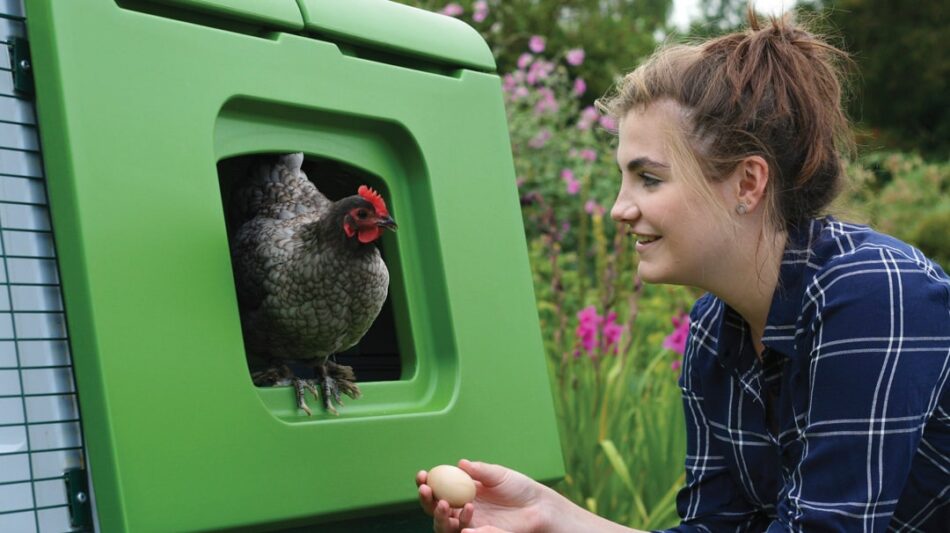

This entry was posted in Chickens on August 18th, 2021 by alisa.deluca
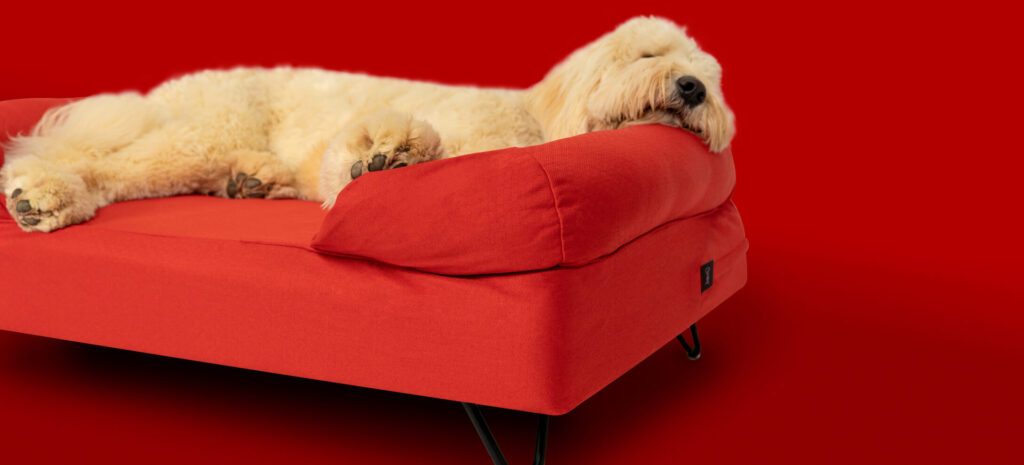
For years dog owners have been limited to beds in dull shades of brown, grey and black, but things are about to change! The Omlet Bolster Beds are now available in 15 amazing colors, ranging from a stylish Meringue White to an eye-catching Cherry Red, so there is sure to be one you will love.
Are you having trouble choosing? Why not try and match the color of the bed to your dog’s personality? We’ve put together a quick quiz that will help you establish which color Bolster Bed will be the perfect style for your pooch. Choose the answers that most resemble your dog, and add together the results at the end to find out which color will suit them best!
What is your dog’s idea of a perfect day?
A. Snoozing on their bed not getting disturbed
B. Playing with the other dogs in the park
C. Going for a walk in the city sniffing outside shops
D. Digging a big hole in the garden
E. Hiking up a mountain
What’s your dog like with strangers coming to your home?
A. Doesn’t pay any attention to them whatsoever
B. Jumps up and down and barks as soon as someone knocks on the door
C. Comes to have a look, but then goes back to whatever they were doing
D. Tries to get a belly scratch from anyone, doesn’t matter if they’ve never met them before
E. They will love to come and say hello, but can tell if the guest doesn’t want to play with them
What is your dog’s coat like?
A. Very, very fluffy
B. Long in some places, short in others – a bit of a mess really
C. Perfectly soft and smooth, we brush it every day
D. Short and easily maintained
E. They’ve got a lot of it, that’s all I’ll say
What is your dog’s favorite treat?
A. Dry duck filets
B. Filet’s from the butcher
C. Ridiculously expensive organic dog treats
D. Probably pizza, or anything else they’re not supposed to eat
E. Just normal dog treats will do
How does your dog feel about bath time?
A. They hate it!
B. Bath time? Are you supposed to wash dogs?
C. Loves it, especially at the groomers
D. They enjoy getting sprayed with the hose outside, but I wouldn’t trust them in my bathroom
E. They accept it, but they’re not a big fan
What is your dog’s favorite time of year?
A. Springtime, it’s warm but not too hot
B. Summer, they love going to the beach
C. They really don’t like snow, but apart from that they don’t really mind
D. Christmas, or any other time when the whole family is together
E. Probably autumn, they love jumping in the leaves
What would be your dog’s reaction to meeting a squirrel on your walk?
A. They would just look at it and keep walking
B. They would chase it up a tree, then try to climb the tree themselves
C. They would bark, but wouldn’t run after it
D. They would run after it hoping to make friends
E. They would look at me, asking for permission to chase the squirrel
If your dog was reading a book this summer, what type of book would it be?
A. A book about World War II
B. Something the other dogs in their doggy book club had chosen
C. A romance novel
D. The latest crime best seller
E. A Russian classic

Mostly As: It is clear that your dog is as relaxed and easy going as dogs come; they are happy to go along with most things as long as they have a comfy bed to come back to for a snooze. A Mellow Yellow bed will be perfect for him or her to rest their head on after walks and play.
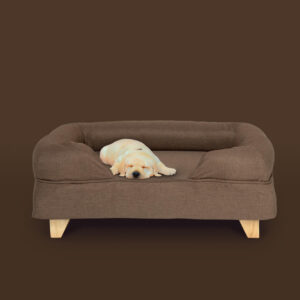
Mostly Bs: Your dog is a feisty one, full of energy and play. We think that a Mocha Brown bed will be perfect for him or her. The soft and subtle brown color will look great in any room of your house, and against whatever color your dog’s coat is. As a bonus, the inevitable muddy paw prints front our dog’s adventures will be camouflaged on the bed!

Mostly Cs: Midnight Blue is no doubt the color for your dog. A stylish and sensitive soul, he or she will love relaxing against the calming blue after a busy day out on the town, and you will appreciate the way the dog bed adds a bit of color to your home while still blending in nicely with the rest of your furnishings.

Mostly Ds: It’s clear that your dog will love a Lavender Lilac dog bed. They are a social creature who want nothing more than to spend time with their favorite humans, it doesn’t matter if it’s on a walk or lying in the corner of the kitchen while you’re having dinner. The relaxing dark purple color will be great for when they are tired and need to wind down.

Mostly Es: Your dog is adventurous and has lots of energy, he or she probably never slows down, and is always happy to chase a ball in the backyard or park or go for a run across the fields. You’re probably very similar, so we think a Matcha Green bed will be perfect for those rare times when they actually retreat to their bed to rest those legs.
This entry was posted in Dogs on August 16th, 2021 by alisa.deluca

Many of us have worked from home over the past year with our best furry friends beside us, giving encouragement and comfort on the toughest of days. It’s understandable for those people that going back to the office without their canine companion could be nerve wracking and upsetting. For the dogs who are now used to constant company, new spouts of being home alone could lead to anxiety and stress. But what if there was a better solution? What if your workplace was dog-friendly? Read on as we take a look at the benefits for all parties…
How do dogs improve our mood?
It’s no secret that dogs, and pets in general, are good for our physical and mental well-being, whether that be through easing loneliness, encouraging exercise, or reducing anxiety, stress and depression. You might have felt it yourself when returning home to your dog, or perhaps going to visit a friend’s new puppy. Interacting with dogs increases our levels of the hormones oxytocin and serotonin, which are important for the regulation of stress and anxiety and also improve our mood and happiness.
Having a dog present in an office environment can significantly elevate the mood, while also improving communication, reducing tension and increasing productivity!
Can a dog-friendly workplace benefit employers?
Not only will your boss enjoy the mood-boosting benefits of a new four-legged colleague, they may also begin to notice some practical benefits for their business too.
For some employees, especially those who have been working from home for a long time now, going to the office requires someone to look after their dog, perhaps hiring a dog walker to take them out or even a hurried trip home in their lunch break to check on their dog. Understandably, this in itself can be a cause of stress for any dog owner, and being able to take their dog to the office with them is a huge job-perk which could be hard to walk away from. Could a dog-friendly office actually improve employee retention? Woof!
Do dogs enjoy going to the office?
Obviously it’s not all about us. If you’re going to be taking your dog to the office you also need to consider whether he/she will be comfortable with the new environment.
If you’re thinking about taking your dog to work for the first time, you may have to accept that the first few trips won’t necessarily be a walk in the park! Start slowly if you can, introducing your dog to colleagues and spaces gradually so as to not overwhelm them. Have a bed next to your desk so your dog can see you at all times and reward them with treats and pets regularly.
Maybe not after the first visit, but hopefully soon your dog will relax into the new environment just as if they’re at home, and new faces, sounds and smells will no longer be a cause of excitement or stress. Instead, they will feel the benefits of being close to you, just as you do!
What should you consider before taking your dog to the office?
If your boss has given the green light to bring your dog to the office, there might be some things to check before going ahead. Of course, check in with your colleagues that no one has allergies or is afraid of dogs. If other colleagues are also going to be bringing their dog to the office, consider whether your dog will be okay with that, or if it could cause some stress.
Make sure you can schedule breaks in your day to take your dog outside to stretch their legs and go to the bathroom – this fresh air time is also great for your own well-being. Make sure you have everything with you, including treats, poop bags, a water bowl and a comfy bed where your dog can feel comfortable and relaxed. You may wish to keep a set of these items at the office if you’ll be bringing your dog with you regularly.
Whether or not you decide to take your dog to the office, the most important thing is that your dog is happy and comfortable. If you are returning to full time office working, consider your options to decide what’s best for your dog.
This entry was posted in Dogs on August 11th, 2021 by alisa.deluca
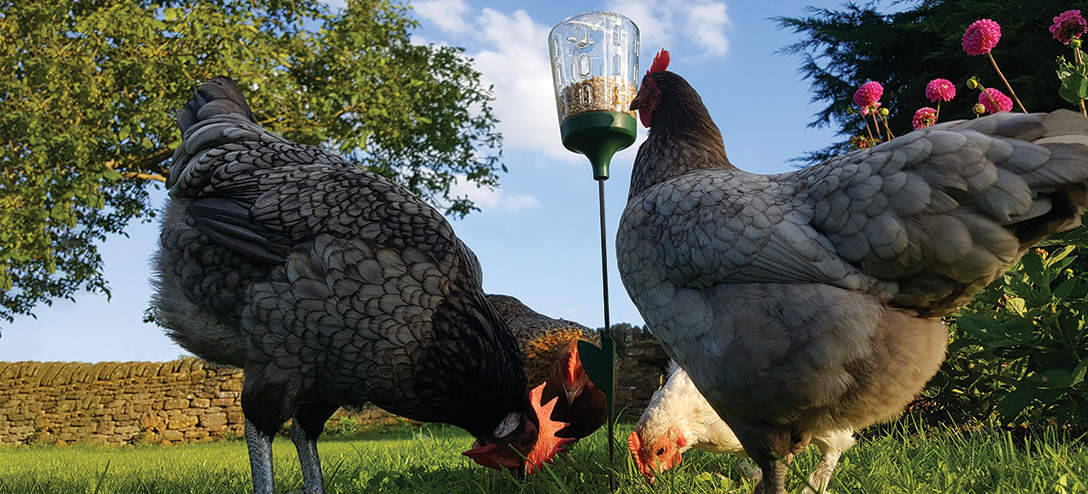
Chickens are not only great companions, but also a great way of being more resourceful, providing you with a frequent supply of fresh eggs. However, you could have a problem on your hands if you begin to notice that a few eggs are going missing. Sometimes chickens develop a bad habit of eating their own eggs, which although is not detrimental to their health, is a sure sign that something is not right.
Your Chickens are Bored
Your poor chickens may simply be suffering from boredom! Boredom in chickens can occur when they either don’t have enough space to roam, or they’re lacking facilities to keep them entertained.
For a happy hen, they need a bare minimum of 1 square meter each in their run, however 2 square meters plus (per hen) is always preferable. Chicken toys are also a fantastic way to keep your chickens entertained. How about trying out the Omlet Pendant Peck Toy, an interactive and engaging feed toy that not only improves flock behavior but will provide your hens with the mental stimulation they desire.
Dehydration
Chickens that eat their eggs may be dehydrated. Since eggs contain a large amount of water, your chickens may be resorting to eating them simply to keep themselves hydrated.
To stop egg eating behavior, make sure that your hens are supplied with a clean water bowl/feeder at all times. During the warmer summer months, chickens need a lot more of it, so add some ice to their bowl or feeder to make sure they stay on top of hydration.
Vitamin Deficiency
A vitamin deficiency can be another reason as to why your hens have turned to egg eating. Your chicken’s diet is fundamental to their wellbeing, and a poor one could be depriving them of their nutritional requirements. Along with eating eggs, broken eggs can be another indication that your chicken is vitamin deficient, more specifically suffering with a calcium deficiency.
It’s important to provide your chickens with a balanced diet of enough protein, carbohydrates, vitamins, and minerals, so although they naturally forage, you should supply your chickens with a good quality feed. For added calcium, it’s recommended to add grit, a ground hard substance, to your chicken’s diet, which aids with digestion. Surprisingly, you can feed your hens crushed eggshells, or alternatively, you can use crushed oyster shells – a high calcium, soluble grit.
Inadequate Nesting Facilities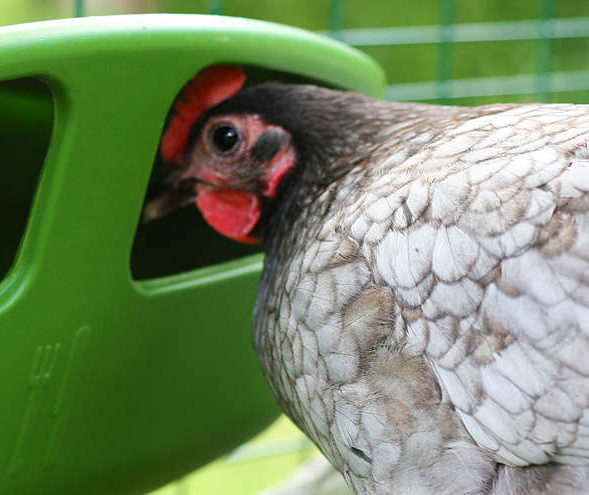
Your nesting box needs to be a secure and safe space for your hens. Egg eating can occur when your hens are uncomfortable with the nesting box, most commonly due to the bedding itself or exposing your chickens to too much light.
First of all, make sure that their nesting area has adequate bedding and is made of a comfortable nesting material. There are a number of choices of bedding to choose for your hens so if you notice that they are not getting on with what you’re currently using, try changing their bedding to see what works best for them. You’ll also want to keep on top of cleaning their bedding by replacing it weekly, also removing any droppings. The Eglu chicken coops make for easy cleaning, with integrated and private nesting boxes, whilst offering plenty of space that your hens will love.
An Anxious or Stressed Chicken
Chickens found to be eating eggs can also be suffering from stress or anxiety, which your hens can be experiencing for a number of reasons. Stress-inducing scenarios can be related to either handling, a new environment, the introduction of new chickens, extreme heat, or regular visits from predators.
Having an anxious hen isn’t pleasant for either you or them but fear not, as there are steps you can take to help minimize stress to help your egg eaters. Some stressful situations are easier to tackle than others, such as introducing new chickens or handling if these are two stressors. Take a look at Omlet’s guide on introducing new chickens for some more help.
Still Struggling?
If you’ve tried all of the above, ruled out anything medical, and yet your flock remain stubborn with their egg eating habit, here’s what else you can do to try and tackle the problem:
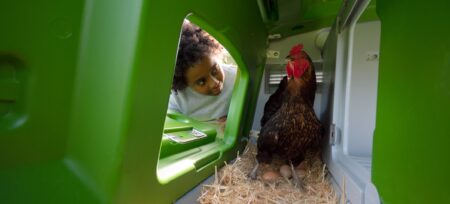
Quickly Collecting Eggs
Quickly collecting eggs once they have been laid will give your chickens, or particular offender if it is just the one hen, less opportunity to eat the eggs. If possible, check the next box four times a day to start with. Hopefully after a few days, this will break the habit, and you can go back to collecting the eggs once a day.
Fake Eggs
Fake eggs can be made of wood, rubber, or ceramics and will leave your chicken pecking but will eventually become frustrated so that they’ll stop attempting to peck at real eggs.
Using Mustard
Create a small hole in your egg, empty the contents and fill with mustard. Mustard is a flavor that (most!) hens can’t stand so after a few attempts, they’ll likely stop attempting to eat eggs.
If you do have an egg eater on your hands, don’t panic! It may seem a bit odd, or the behavior might confuse you but with a few tips you can get the habit well under control. Hopefully next time you go to collect eggs, you’ll have happy laying hens, with your eggs still intact!
This entry was posted in Chickens on August 6th, 2021 by alisa.deluca
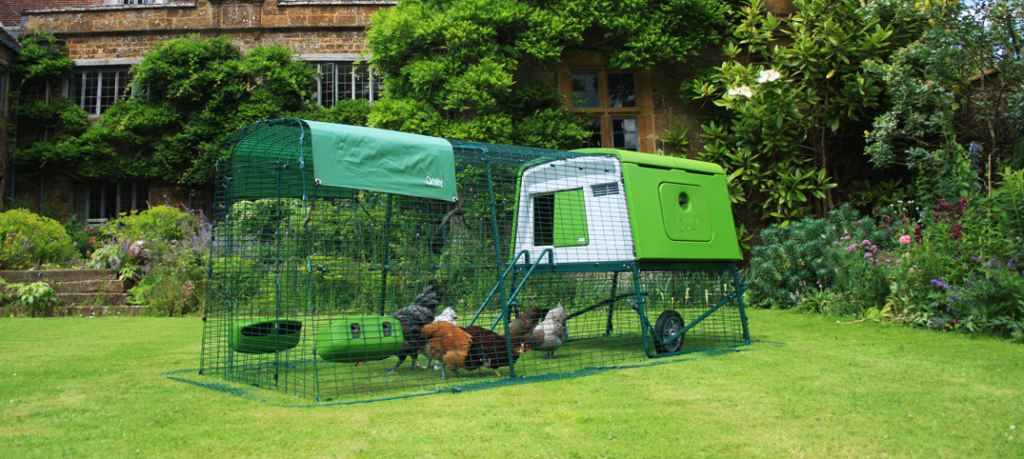
The metal chicken runs are designed to be used outdoors for years to come. However, we recommend that you check the run regularly for signs of corrosion, especially if you live somewhere with extreme weather conditions or close to the sea. Corrosion will occur if the coating has been scratched or scraped for example. If you do see some, remove any loose rust and touch up with a weather resistant paint.
Are you a long term Eglu or Walk in Run owner? Omlet products are known to be extremely long lasting, but we do recommend checking over your coop and run every year for signs of wear and tear, and to remember the little maintenance needed to keep your coop in tip top condition and your pet happy and healthy. You may have also missed some of the new products we have developed over the years to make the coop and runs even better. Take a look at ways you can upgrade and improve your Eglu below!
Run Clips
When you carry out your regular deep clean, make sure you have a quick walk around the run and check the security and stability of the run panels. In time, the run clips can age and become weaker. If you notice that run clips are cracking when you open them or move the coop and run, or that there are some clips falling to the ground, you should consider refreshing all the run clips on your coop.
We have now made it super quick and easy for you to find the right pack of run clips for your Eglu or Walk in Run.
New Ladder
If you purchased your Eglu before summer 2019, you may not have benefited from the new Ladder Grips we have designed to resolve the problem of some chickens disliking the metal coop ladder, or being too small for the steps. The ladder grips replace the black friction strips, clipping on securely and easily to provide a wider platform for chicks to climb up on.
You can buy ladder grips for your Eglu Cube here or for your Eglu Go UP here.
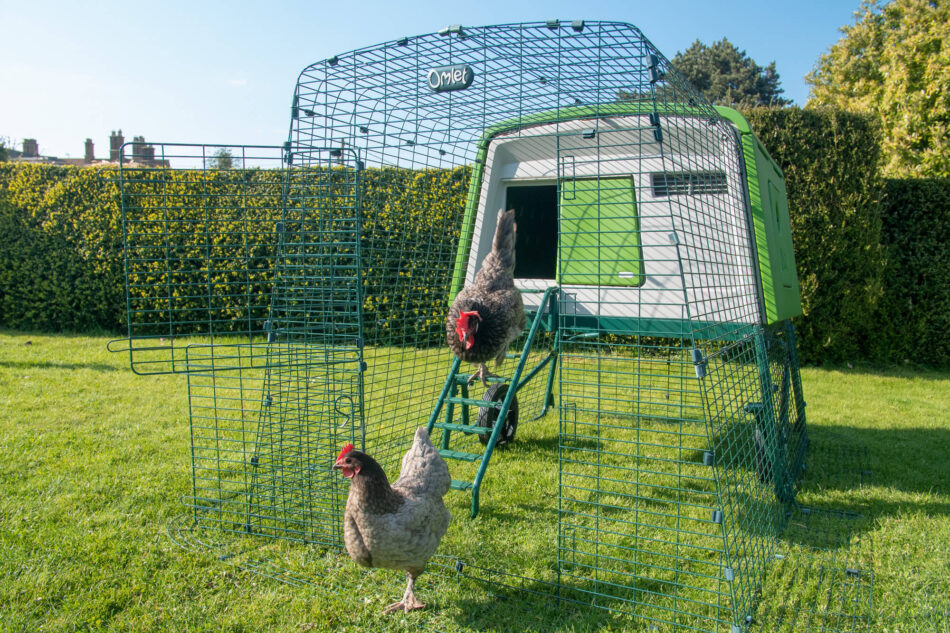
Autodoor and Coop Light
We’re sure you haven’t missed the Automatic Chicken Coop door that can be attached straight onto your Eglu Cube or Walk In Run, but have you seen that you can also attach a coop light to guide your chickens in at night? The light is powered by the control panel of the Autodoor, and will automatically come on 5 minutes before the door closes. As soon as the door has closed for the night, the light turns off.
Run Covers
In high winds and torrential rain, old run covers can take a beating. If you have had your run covers for some time and they are looking a bit worse for wear, it might be a good idea to invest in a new set of covers to ensure your chickens continue to be fully protected from the elements.
Discover our wide range of run covers for all Eglus here.
New hentertainment
We have also introduced new feeders and treat dispensing toys in the last few years, which your chickens are sure to love.
The Caddi Treat Holder is ideal for larger treats, such as fat balls or vegetables from your garden, and hangs in your run to keep food off the ground and prevent mess on the run floor. The Peck Toys are a rewarding, slow release solution for treat-dispensing which your chickens will be entertained by all day. The Pendant hangs from the run, while the Poppy is put into the ground – perfect if your chickens are fully free ranging.
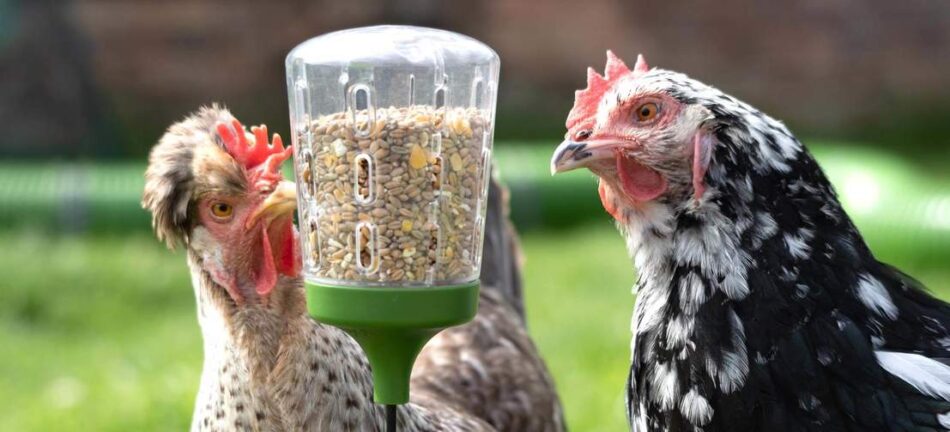
We’re here to help
If you are unsure about the condition of your Eglu or your run, please contact our friendly and knowledgeable Customer Service team. They can give you advice on how to maintain your product, making sure it’s in top condition for many years to come!
This entry was posted in Chickens on August 3rd, 2021 by alisa.deluca



